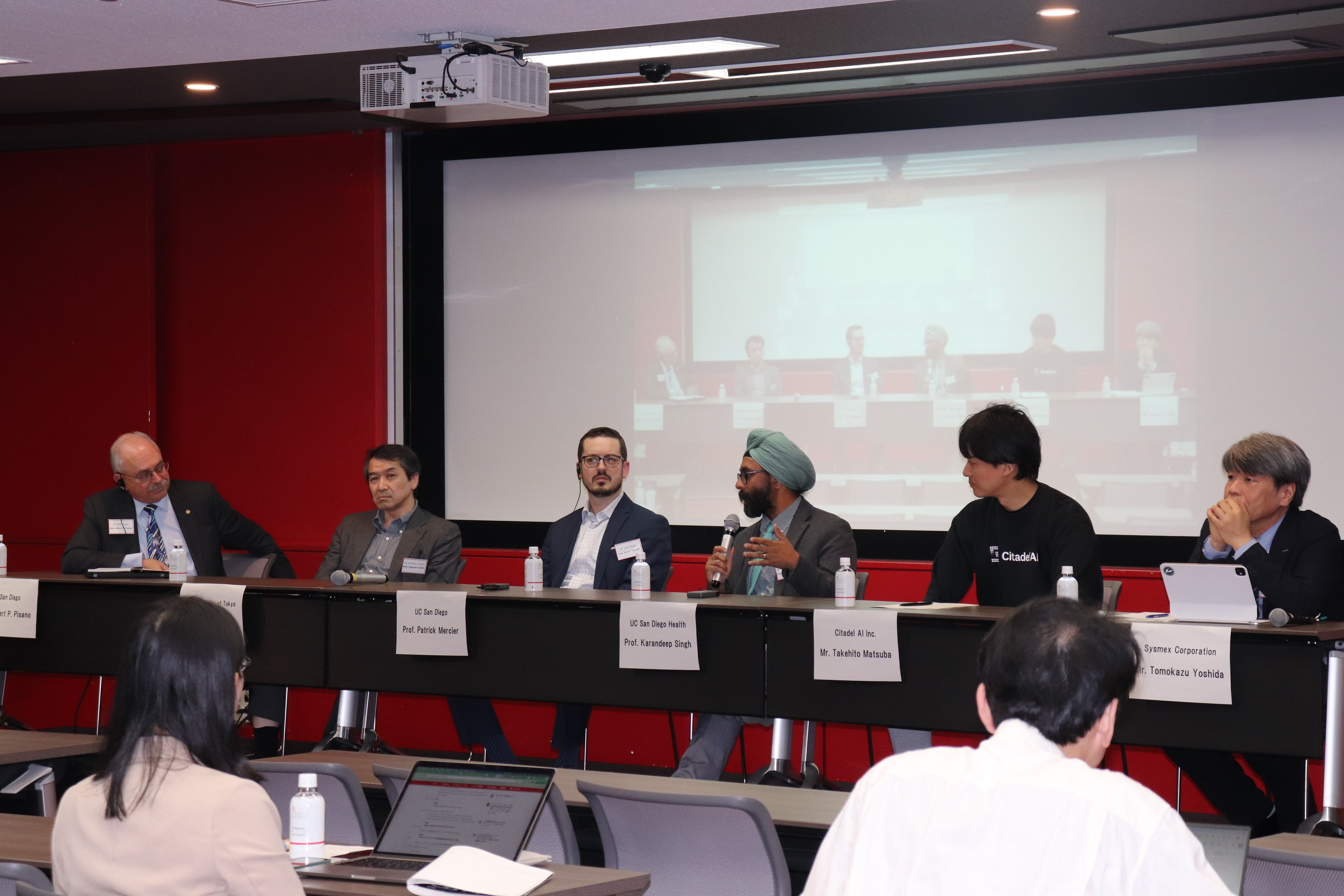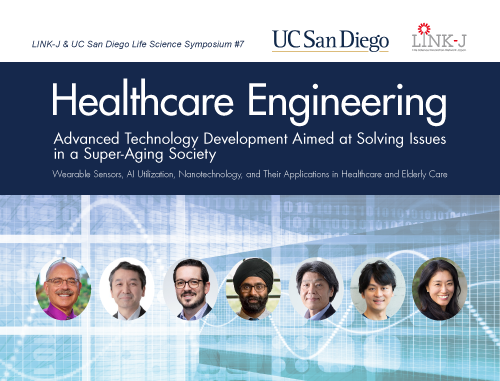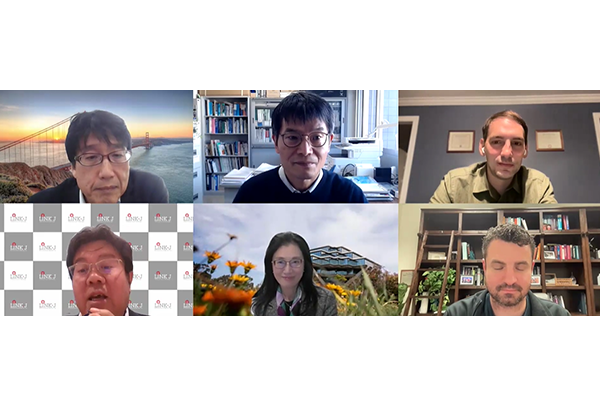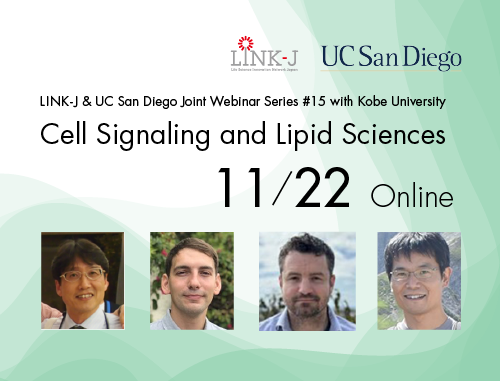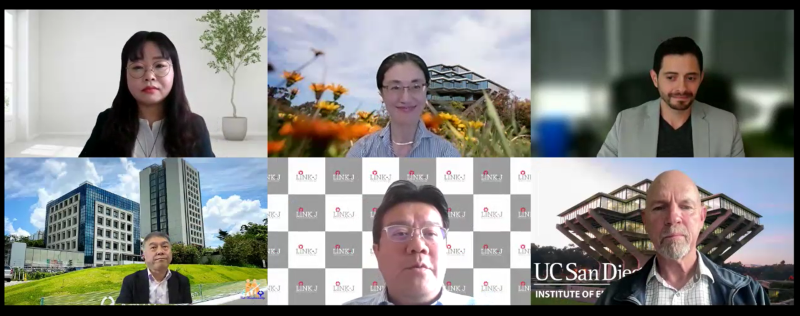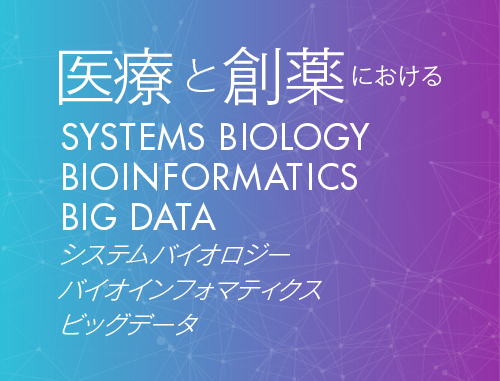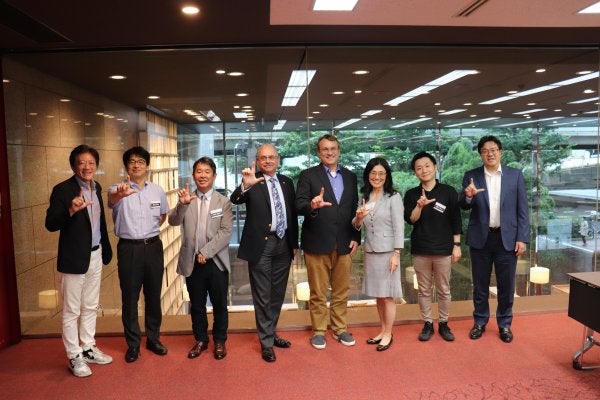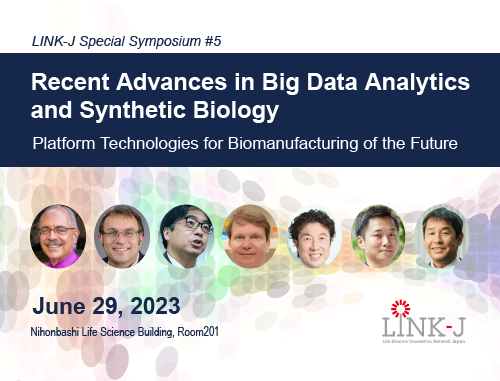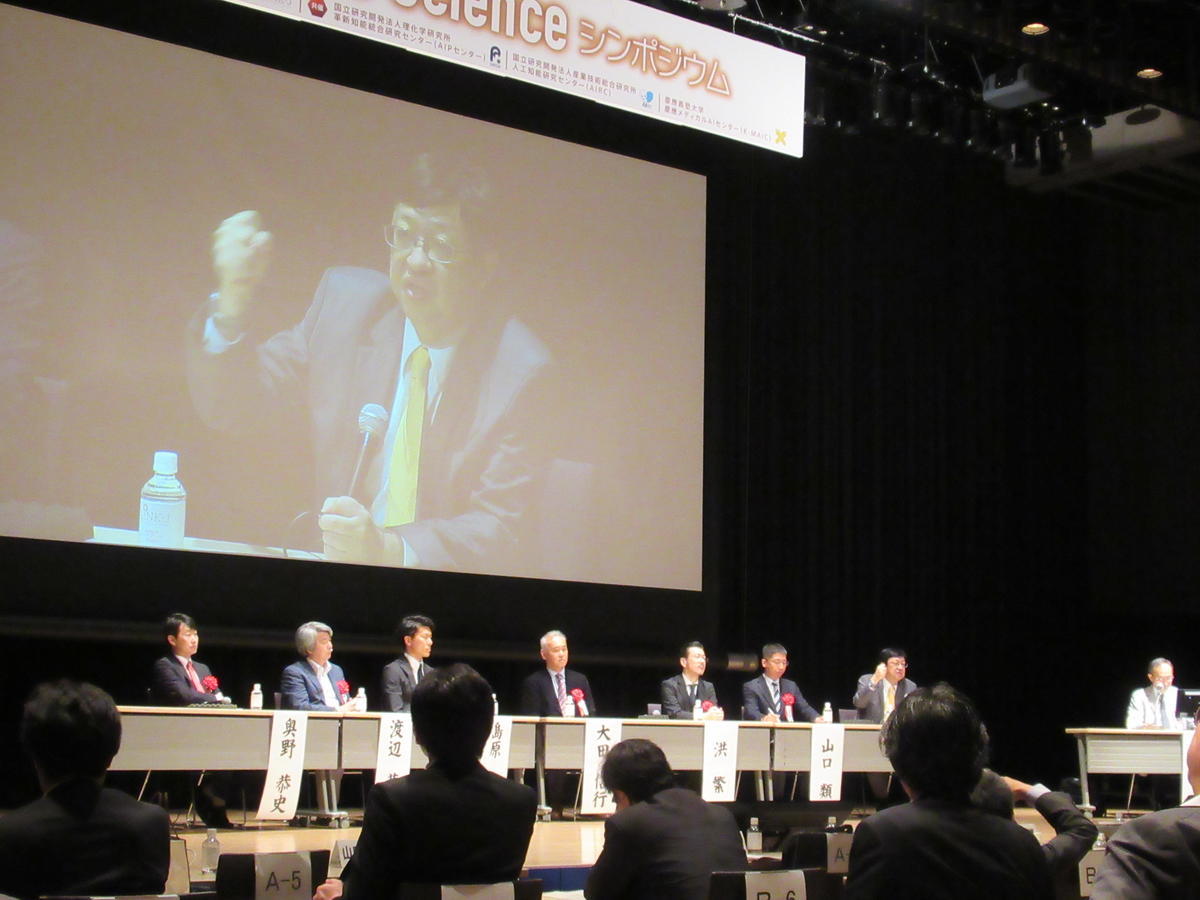LINK-J and the University of California San Diego (UC San Diego) co-hosted the Symposium "Systems Biology, Bioinformatics and Big Data in Medicine and Drug Development" at Nihonbashi Life Science Building on February 22, 2019. The symposium consisted of four lectures by Dr. Trey Ideker and Dr. Nathan E. Lewis from UC San Diego , Dr. Jun Seita from RIKEN and Dr. Hiroaki Kitano from the Systems Biology Institute. The four leading systems biology experts gave exciting lectures in the first half of the symposium. In the second half, an active question and answer session was held during the panel discussion. Following the symposium, a networking reception was held in the friendly atmosphere.
Opening remarks :
Miwako Waga (UC San Diego )
Akihoko Soyama (LINK-J)
Lecturers :
Dr. Trey Ideker : Professor of Medicineand Adjunct Professor of Bioengineering & Computer Science, University of California San Diego
Dr. Nathan E. Lewis : Associate Professor of Pediatrics and Bioengineering, and co-director of the Jacobs School of Engineering CHO Systems Biology Center, University of California San Diego
Dr. Jun Seita : Unit leader of RIKEN Medical Sciences Innovation Hub Program; senior research scientist of RIKEN Center for Integrative Medical Sciences, research scientist of RIKEN Center of Advanced Intelligence Program, visiting scholar of Stanford University Institute for Stem Cell Biology & Regenerative Medicine
Dr. Hiroaki Kitano : President & CEO of Sony Computer Science Laboratories, Inc., senior vice president of Sony Corporation, president at the Systems Biology Institute, and professor of Okinawa Institute of Science and Technology Graduate University
Lecture 1: Decoding genomes through the hierarchical architecture of the cell
Dr. Trey Ideker
- The current deep neural network has a black box or hidden layers.
- The hierarchical structure has been clarified through the analysis of a functional network in tumor cells.
- The hierarchical structure has enabled deep learning with the black box section visualized.
Dr. Ideker gave a lecture on the utilization of AI and deep learning in biomedicine and related issues. The black box issue was used as the first example. The processing mechanism has not been visualized in intermediate layers for a deep neural network, which is mainstream for current deep learning. Dr. Ideker proposed that it would be necessary to understand processes in the biomedical field as well as answers.
The latter is a big data issue. AI and deep learning have attracted public attention for several years, such as the advent of self-driving technology and the victory of AI in games against go players. According to Dr. Ideker, the amount of big data in the biomedical field is not as large as in the fields of automated driving and go. He also mentioned complexity as a third issue. He highlighted the differences between biomedicine and go: the rules in the biomedical field are not as simple as in the game of go, and we are not necessarily aware of the rules.
Dr. Ideker and his colleagues first tried to elucidate and map the mutual relationship among tumor genes through genomic analysis of tumor cells (and later in the field of psychiatric and neurological diseases) to discuss new rules for deep learning. They found that two different networks were involved in the occurrence of tumor cells, and at the same time successfully visualized the process from gene mutation to tumorigenesis. Additionally, they concluded through research on the tumor gene network that the network was not flat but had a hierarchical structure.
Next, Dr. Ideker and his colleagues tried to visualize deep learning using the hierarchical structure in the deep neutral network. His team first modeled the structure using the yeast with the simplest structure and supplied training data before simulating the cellular proliferation rate of yeast. Consequently, they found a correlation between the results of the simulation and the experimental results, which confirmed that the precision was as high as the conventional black box model. He calls the novel methodology new biology-inspired deep learning.
Dr. Ideker pointed out that the biomedical field does not utilize deep learning effectively. He also referred to his prospects that more facts would be clarified in the future based on new research projects, using the elucidation of the network through a yeast model as a foothold. He is currently working on research on the application of the methodology for tumor cells. He confidently said that he would be able to discuss it at the next symposium.
Lecture 2: Engineering mammalian cell factories with big data and systems analysis
Dr. Nathan E. Lewis
- Biopharmaceuticals dominate the sales ranking of pharmaceutical products.
- Big data and systems biology will contribute to the efficient production of biopharmaceuticals.
- The knockdown/knockout of specific genes will release the natural secretion function of cells.
Dr. Lewis's lecture was on the engineering of antibody generating cells using big data and system analysis. Looking at sales trends in the current global ethical drug market, most leading products are biopharmaceuticals, and more than a half of them are based on mammalian cells (Chinese hamster ovary cells, hereinafter, "CHO cells"). According to Dr. Lewis, the issue with biopharmaceuticals is the high cost, because they should be manufactured from cells.
Therefore, the pharmaceutical industry has tried to reduce the production cost by increasing the antibody production per liter of medium through the optimization of bioreactors. However, in actual production, the current manufacturing methods are not always best from an economic perspective due to a wide range of restrictions imposed. Under these circumstances, Dr. Lewis wondered if the antibody production might be increased by modulating host cells using cell engineering technology.
The effective use of big data in biopharmaceutical production was a large challenge for pharmaceutical companies. Big data was obtained with the advent of the next-generation sequencer. However, there were some issues with its biological interpretation and transfer to cell engineering. Dr. Lewis thought he would be able to address the issues by analyzing big data using systems biology. His team verified and analyzed numerous research articles about CHO cells, in other words today's main biopharmaceutical technology, and constructed a simulation model of the antibody production path based on the results.
Then Dr. Lewis and his colleagues simulated and examined the influence of the knockdown/knockout of specific genes on antibody production using a computational model. They discovered that the methodology raised the titer of generated antibodies, increased the living cell density and suppressed unnecessary antibody secretion. Dr. Lewis said that the research created a situation where the innate secretion capacity of cells could be used freely. "There would be large cost benefits if the production of required antibodies could be increased by the selective knockdown of the genes for the antibody components that compete within cells," said Dr. Lewis.
With respect to past research, Dr. Lewis pointed out that they tried to elucidate the elements significantly affecting antibody production in cells by analyzing big data and implementing a systems biology approach. He also mentioned that they materialized the cell engineering technology based on new data and algorithms. He predicted that the future would demand more efficient host cell development through the further use of data.
Lecture 3: Systems-level understanding of gene expression profile based on global meta-analysis
Dr. Jun Seita
- Systems biology is important for the elucidation of complicated life phenomena.
- The developed Gene Expression Commons will help with the objective understanding of all gene expression.
- We are responsible for elucidating cellular phenomena for patients through systems biology.
Dr. Seita discussed systems biology, the science for evaluating life phenomena. Past research clarified that humans had approximately three billion base pairs, and approx. 20,000 genes produced about 100,000 kinds of protein daily. He thinks that systems biology can answer the question of how to understand such a complicated structure.
However, past genome research did not achieve public understanding when Dr. Seita began his research. The analysis by conventional microarray technology did not allow him to understand the overview due to the difference in sensitivity among genetic probes, although it permitted an approximate assessment of genetic expression by comparing two or more samples. He focused on the dynamic range of genetic expression as a solution.
First, Dr. Seita collected the gene expression data entered in the Gene Expression Omnibus (GEO, the database repository of gene expression data administered by the National Institutes of Health, the U.S.A.) in collaboration with computer science experts from Stanford University. Next, he calculated the dynamic range of each genetic probe using meta-analysis of the collected data to construct a database. As a result, it allowed researchers to obtain an overview of the expression of all genes by mapping their microarray data that researchers had on the database. Now, you can get an objective picture of the data.
Dr. Seita also tackled the final issue--accessibility of the completed database. He developed Gene Expression Commons, an original open platform, at the request of the professor of the laboratory to which he belonged at that time. The professor said, "I want you to make a database to that even I can access." The database features an easy-to-use intuitive interface, highly reviewed by the people concerned. According to Dr. Seita, the database now has more than 5,000 users and more than 2,000 projects in over 60 countries.
In the pharmaceutical world, the new cell therapy genre has prevailed over conventional low molecular weight compounds. In addition, the Regenerative Medicine Products and Biotechnology Subcommittee of the Ministry of Health, Labour and Welfare approved the new cancer immunotherapy using T cells two days before the event. Dr. Seita emphasized the importance of the elucidation of life phenomena using systems biology, calling it a responsibility that they bore for patients.
Lecture 4: AI-Driven Systems Biology
Dr. Hiroaki Kitano
- Today's scientific discoveries still depend on serendipity, accidents and researchers' intuition.
- AI and deep learning can serve as an engine for new discoveries in systems biology.
- Some day, AI will achieve the automated discovery of scientific knowledge.
Dr. Kitano gave a lecture about systems biology and AI. Originally, systems biology was a concept advocated by Dr. Kitano in the late 1990s. Having engaged in the systems biology field for over 20 years, Dr. Kitano asserts that it is difficult for humans to construct a vast amount of data and knowledge that are added day after day, and it is already impossible for human researchers to read and understand all research papers and extract the important knowledge from them, because approx. two million research articles are published each year in the life science field alone.
Dr. Kitano introduced simulation models based on computers and started to proactively use them very early in his research. It took three to four months for the early models to perform a simulation at least 500,000 times to find specific mechanisms of molecules because of the low computational speed. However, according to Dr. Kitano, the development of computational models was his only accomplishment completed with full confidence. He relied on his researcher's intuition when defining issues, generating and selecting hypotheses, or making a biological interpretation. Recalling the past, he said that he had just happened to choose the right answers.
Through such experience, Dr. Kitano started to wonder if he could make a new engine for scientific discoveries using AI. He pointed out that scientific discoveries still depended on serendipity, accidents and scientific intuition. He noted that the process of discoveries in modern science is still at the pre-industrial revolution level.
That is why Dr. Kitano first developed the open platform GARUDA. Securing compatibility between databases or software programs, the platform for researchers incorporates machine learning and deep learning. He tried a variety of uses, such as text mining existing literature and the construction of an influenza viral infection response pathway. For applications in healthcare, he has been involved in joint research on patients with rheumatoid arthritis in collaboration with the University of Tokyo and RIKEN to discover new medical knowledge by classifying patients using deep learning.
Dr. Kitano is currently trying to upgrade the performance of AI through such projects as the Nobel Turing Challenge, which is a competition to enable Novel-prize-deserving scientific discoveries using AI. Dr. Kitano showcased his positive prospects and expectations for more interesting research results to be published in the future while stating that AI had not yet realized automated scientific discoveries.
Panel discussion
A panel discussion was held based on participants' questions, chaired by Dr. Kitano, following the discussions by the four lecturers. When one participant asked if it was necessary to discuss chronological changes in a profile of genetic expression, Dr. Ideker replied that there were no useful tools for discussing chronological changes at the moment, and only static data was obtained after pointing out that the question referred to a very important point. Dr. Seita said that the question would be answered in a couple of years.
Dr. Nathan asserted that researchers should consider how to use limited data effectively, pointing out that systems biology currently had some challenges to overcome due to the very small size and limited diversity of big data. Dr. Kitano mentioned that the data was not very diversified, including a lot of noise (unnecessary data), and also inferred that it would be very difficult to discover universal rules even if lots of data was collected so long as it remained less diversified.
As for the recent trends in deep learning and AI, Dr. Seita revealed his desire to escape from the current situation of excessive expectations. He also described that it would be ideal if people understood and used deep learning and AI as part of the medical tools acquired by humans. Dr. Ideker agreed that people had excessive expectations for deep learning. He also admired that the performance was surprisingly powerful, increasing day by day, and admitted the steady advancement.
After the symposium, a convivial party was held successfully. The lecturers joined the party, proactively answering questions of participants and exchanging opinions.
